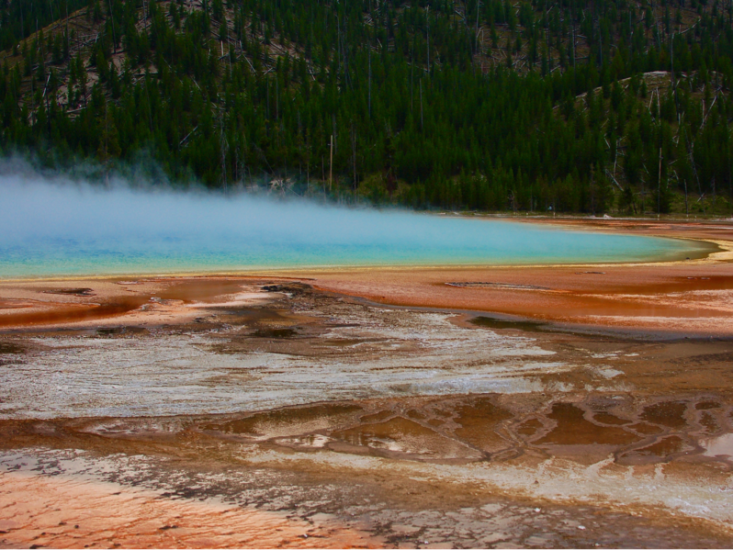
Yellowstone National Park: The Grand Prismatic Spring
Posted on 08/29/2015 5:30:26 PM PDT by markomalley
The wind shifts. The stench of rotten eggs makes it nearly impossible to breathe and the hot fog clouds my view. I hold my breath and close my eyes, imagining the fog growing thicker, crushing me. Then without warning the wind clears and I’m enveloped once again in the cold, dry air. The heat feels like a lost dream. I shiver as I analyze my surroundings.
Before me lies a steaming blue spring with concentric rings of green, yellow and dark red. I turn around to see another pool. But the rising fog is so dense, I can only guess at the existence of blue water below. Sometimes I glimpse bubbles boiling from some unknown source. The pools are a small sampling of the 10,000 geothermal features that dot Yellowstone’s caldera and hint at a mysterious hot spot beneath the crust.
 Yellowstone National Park: The Grand Prismatic Spring |
It’s this alien landscape that makes it surprisingly easy to believe that northwestern Wyoming sits directly above a supervolcano — a behemoth far more powerful than your average volcano, with the capacity to eject more than 240 cubic miles of material.
But why do scientists believe there is a supervolcano hidden below? When I asked Henry Heasler, a park geologist at Yellowstone this question, he waxed philosophical. “Good science is nothing more than a progress report,” he said. “It’s what we know at a certain time with the data that we have.”
And this year scientists provided one of the most impressive progress reports yet: They peered deep beneath the Earth’s surface and created the first three-dimensional image of the supervolcano’s plumbing. Although they had already imaged a plume, which brings molten rock up from deep below the mantle to a region about 60 kilometers below the surface, and a magma chamber about 10 kilometers below the surface, the new work had found the missing link between the two.
A second, 11,200-cubic-mile magma chamber connects the plume to the shallower magma chamber. It’s 4.5 times larger than its shallow companion and has enough hot rock to fill the Grand Canyon nearly 14 times.
Hsin-Hua Huang, a seismologist from the University of Utah and his colleagues used earthquake data to capture this astonishing image. It’s similar to an ultrasound, said Heasler. “We have the skin of a surface—of a person—but we want to see what’s inside.” When earthquakes travel through dense, hot spots they slow down. So if a seismic wave reaches a sensor later than expected, scientists know there’s a low-velocity, and hence denser and hotter, region hidden deep within the Earth.
“If we were just using one pathway—so one earthquake and one seismometer—we couldn’t be able to tell where along that path that low velocity body was. We’d have no idea,” said co-author Jamie Farrell from the University of Utah. That’s where multiple earthquakes and sensors come into play. Huang’s team used 4,849 earthquakes, originating from all parts of the earth, plus 80 seismographs across Yellowstone and beyond, to create a rough three-dimensional picture.
Their study was also the first to combine both worldwide and local earthquakes. Distant earthquakes allow scientists to image deep structures (any earthquakes originating under India or China will first travel through the Earth’s core before reaching the U.S.) and local earthquakes allow for shallow structures. Combining the two let the team image the deep magma chamber for the first time. Given that natural earthquakes, however, are relatively rare events—even in one of the most active areas in the world—they had to collect 30 years worth of data.
But seismic tomography isn’t the only way to peer deep underground. GPS satellites can scour the area searching for any ground movement; gravity satellites can look for any changes in the density below; and ground instruments can sample the heat and gases rising from the geothermal features.
All methods point to a supervolcano that’s very much alive. From 1976 to 1984, GPS satellite data showed that the caldera floor was swelling upward. Magma was flowing from the deeper chamber into the shallow reservoir, causing the above ground to inflate. This influx of hot material, which happens to be less dense, was also reflected in gravity data. To a satellite orbiting directly above the inflow, the Earth will seem to pull on it a little less than expected. Meanwhile ground instruments measured increasing heat and gases rising from the active features.
Then from 1985 to 1995 the caldera sunk back down about 5.5 inches. Magma was either moving out of the system laterally or the shallow reservoir was simply cooling and contracting, letting gases seep through the surface. Later measurements show that the caldera floor is continuing to swell and sink. But scientists still don’t understand the complex interplay between the supervolcano’s moving parts.
“I think our next step—hopefully—is to be able to look at some smaller scale features of how these bigger features are connected to each other,” said Farrell. If scientists can determine how the large magma chambers interact with each other, they will better understand how fluids and heat move the Earth. “Then we can start looking at how long it would take for enough material to get from the deep to the shallow [reservoirs] and maybe where we are in the volcanic cycle of eruptions. But we’re not quite there yet.”
Although past eruptions dot the Earth’s surface from Oregon to Wyoming, it’s hard to infer anything about a future eruption. And Farrell isn’t convinced another super-eruption will happen at all. “The system might be dying,” he said. “The Yellowstone hot spot is moving into thicker, colder continental crust. And it takes a lot more energy to burn through that crust than it did the thinner crust that it’s been burning through for the last 17 million years.”
But as I watch Yellowstone’s surface boil over before my very eyes it’s hard to believe that the system deep beneath my feet might one day fade away. And as a geyser before me erupts, shooting steam and water tens of feet into the air, I have to wonder if it’s instead slowly building toward another super-eruption. After all, despite Farrell’s uncertainty, he continued to say: “It’s happened in the past, it could happen in the future.”

Here’s a little bitty teeny tiny one, if anybody’s interested -
https://www.youtube.com/watch?v=BUREX8aFbMs
How about the 1959 Yellowstone earthquake and landslip which created Quake Lake & threw Old Faithful’s timing off?
We love this place . Packing up right now to head home to Texas . It was a beautiful week and saw everything except moose . Next time !
what if the supervolcano was named Ditka ?
Then keep Jim McMahon away from Yellowstone.
Is that the Lucha Libre guy? You know I think his American identity is Jeb something.
Just look at the types running the EPA now. The types that believe that humanity is a virus infecting “Mother Erf”, and that the human population needs to be drastically reduced, maybe even destroying civilization in the process. Some talk about releasing a deadly virus.

You forgot to add your /sarc.
If Ditka had run instead of Keys, Dog Food might be an obscure name known to only Freepers.
Great video...
It’s a neat place to visit
It gives you pause to realize that the eruption in that video is less than 1/100th of what they are speculating with Yellowstone.
Which is exactly why I don’t worry about it.
No place to run - no place to hide.
We went to Yellowstone in 2010 and did the 7 mile hole down to the Grand Canyon of Yellowstone. Fishing was out of this world. But it freaked us out. Half way down, the ground became hot to the touch and feet. It seemed to me that this place is going to blow...given our reproach of God these last days...I think it could be a judgment from God like Pompeii, Sodom, or Crete
With time for some of us to say, adios. Others, not so much.
Gonna tell my wife, honey, this might be our last night on earth.........
Disclaimer: Opinions posted on Free Republic are those of the individual posters and do not necessarily represent the opinion of Free Republic or its management. All materials posted herein are protected by copyright law and the exemption for fair use of copyrighted works.